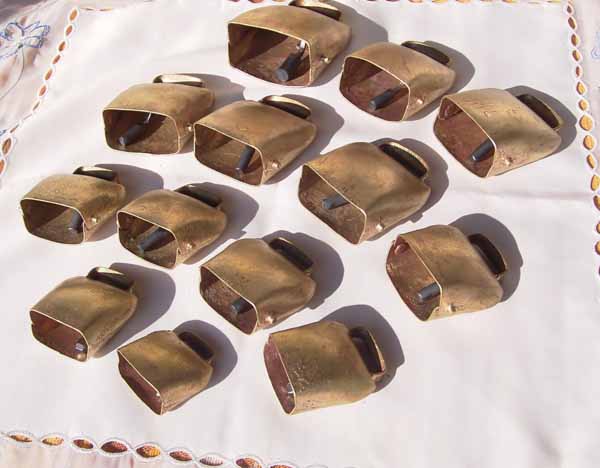|
Gonguê
Gonguê (or Gonguê bell) is a Brazilian percussion instrument. It is a type of Cowbell (instrument) consisting of a big, flat iron bell, measuring from 20 to 30 cm, and a cable that serves as a support. The Gonguê is usually played with a metal drumstick, and it is typically used in north-eastern Brazilian music, accentuating the beats and doing rhythmic phrases, generally formed by off-beats and syncopated patterns. To avoid fatigue, players normally support it against the body. Due to its size, the Gonguê has a loud and strident sound, more clangorous than other types of cowbells. See also * Maracatu * Agogô * Alfaia The alfaia is a Brazilian membranophone. It is a wooden drum made o ... External links BlogBrincante Maracatu Lua Nova References Brazilian percussion {{Brazil-music-stub ... [...More Info...] [...Related Items...] OR: [Wikipedia] [Google] [Baidu] |
Cowbell (instrument)
The cowbell is an idiophone hand percussion instrument used in various styles of music, such as Latin and rock. It is named after the similar bell used by herdsmen to keep track of the whereabouts of cows. The instrument initially and traditionally has been metallic; however, contemporarily, some variants are made of synthetic materials. Origins While the cowbell is commonly found in musical contexts, its origin can be traced to freely roaming animals. In order to help identify the herd to which these animals belonged, herdsmen placed these bells around the animal's neck. As the animals moved about the bell would ring, thus making it easier to know of the animal's whereabouts. Though the bells were used on various types of animals, they are typically referred to as "cowbells" due to their extensive use with cattle. Tuned cowbells Tuned cowbells or ''Almglocken'' (their German name, ‘Alm’ meaning a mountain meadow, and ‘Glocken’ bells), sometimes known by the En ... [...More Info...] [...Related Items...] OR: [Wikipedia] [Google] [Baidu] |
Maracatu
The term maracatu denotes any of several performance genres found in Pernambuco, Northeastern Brazil. Main types of maracatu include ''maracatu nação'' (nation-style maracatu) and ''maracatu rural'' (rural-style maracatu). Maracatu Nação Maracatu nação (also known as ''maracatu de baque virado'': "maracatu of the turned-around beat"), the most well-known of the maracatu genres, is an Afro-Brazilian performance genre practiced in the state of Pernambuco, mainly in the cities of Recife and Olinda. The term, often shortened simply to ''nação'' ("nation", pl. ''nações''), refers not only to the performance but to the performing groups themselves. ''Maracatu nação''’s origins lie in the investiture ceremonies of the ''Reis do Congo'' (Kings of Congo), who were enslaved people who were granted leadership roles within the enslaved community by the Portuguese administration. When slavery was abolished in Brazil in 1888, the institution of the Kings of Congo ceased to exist. ... [...More Info...] [...Related Items...] OR: [Wikipedia] [Google] [Baidu] |
Agogô
An agogô (Yoruba: ''agogo'', meaning bell) is a single or a multiple bell now used throughout the world but with origins in traditional Yoruba and Edo music and also in the samba '' baterias'' (percussion ensembles). The agogô may be the oldest samba instrument and was based on West African Yoruba single or double bells. The agogô has the highest pitch of any of the bateria instruments. Construction Each bell is a different size. This allows a differently pitched note to be produced depending on which bell has been hit. Originally wrought iron, they are now manufactured in a variety of metals and sizes for different sound qualities. The most common arrangement is two bells attached by a U shaped piece of metal. The smaller bell is held uppermost. Either bell may be hit with a wooden stick to make a cowbell like sound or less commonly a clicking sound is produced by squeezing the two bells together. Origins/History/Evolution The Yoruba, Igala, and Edo peoples of Nigeria use t ... [...More Info...] [...Related Items...] OR: [Wikipedia] [Google] [Baidu] |
Alfaia
The alfaia is a Brazilian membranophone. It is a wooden drum made of animal skin tensioned or loosened through ropes placed alongside the body of the instrument. Alfaias are usually between and in diameter. Their construction is similar to 19th-century American and European military or field drums, and Latin American wooden bass drums. Their drumheads are clamped to the body through large wooden hoops, and they are played with distinctly-shaped thick wooden drum sticks. Sometimes the stick used in the dominant hand In human biology, handedness is an individual's preferential use of one hand, known as the dominant hand, due to it being stronger, faster or more Fine motor skill, dextrous. The other hand, comparatively often the weaker, less dextrous or sim ... is marginally larger than the one used in the weak hand. Traditionally strapped over the shoulder, alfaias are played with a distinctive technique in which players hold the weak-hand drum stick inverted to get th ... [...More Info...] [...Related Items...] OR: [Wikipedia] [Google] [Baidu] |




